Report: Analyzing GovDept's Enterprise Architecture Implementation
VerifiedAdded on 2023/01/12
|10
|2773
|68
Report
AI Summary
This report provides a comprehensive analysis of GovDept's Enterprise Architecture (EA) implementation. It begins with an introduction to EA and its strategic importance, followed by an examination of GovDept's projects that need execution, highlighting the crucial role of IT in successful EA implementation. The report details EA artifacts, taxonomy of documentation, and the operating model chosen by GovDept. It explores the roles of landscapes and standards, five essential IT initiatives, and factors to consider as EA artifacts are delivered. Furthermore, the report discusses subtypes of vision within GovDept's EA implementation, concluding with an overview of the key findings and recommendations for future development. The report emphasizes the importance of aligning IT with business objectives to achieve efficiency and growth.
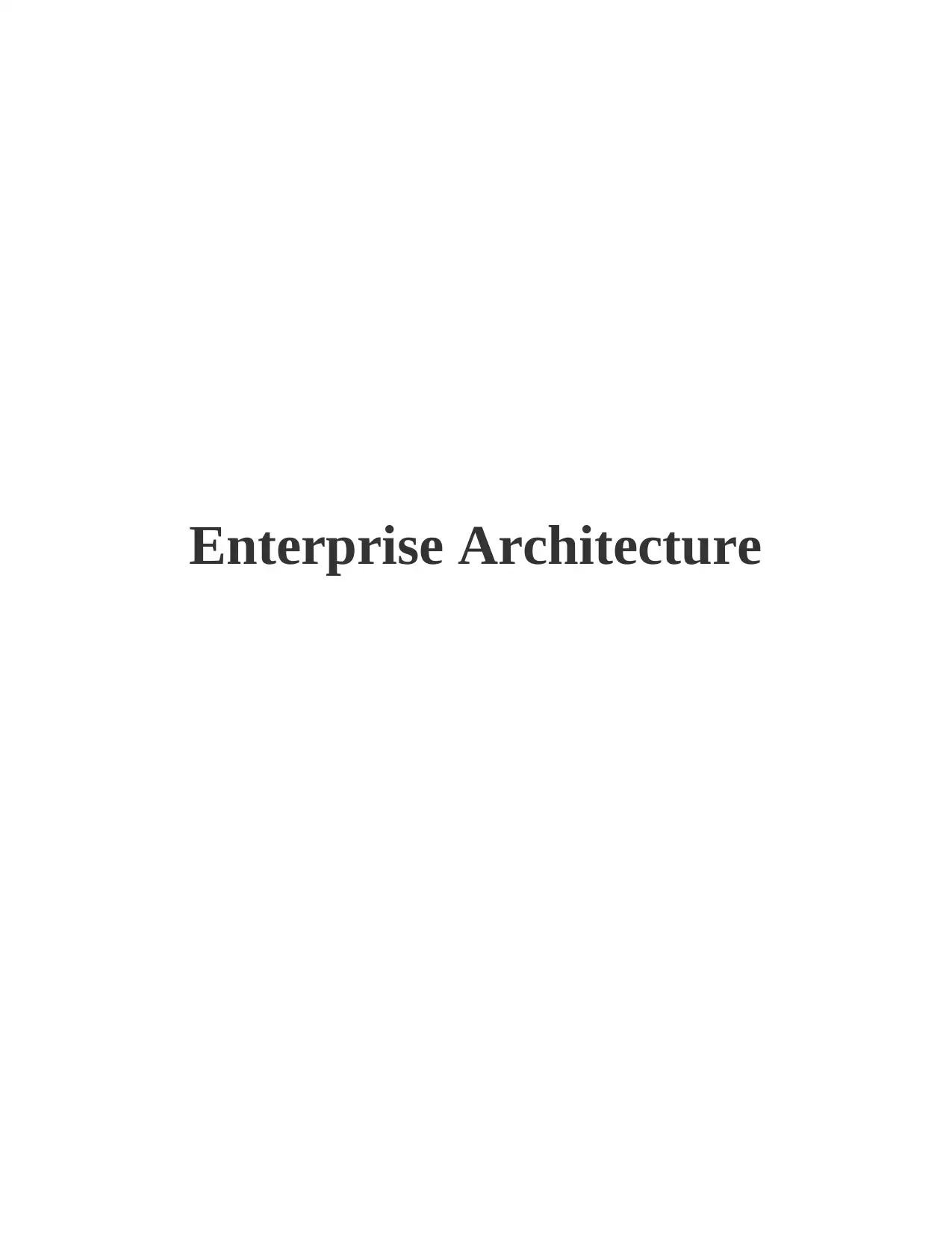
Enterprise Architecture
Paraphrase This Document
Need a fresh take? Get an instant paraphrase of this document with our AI Paraphraser
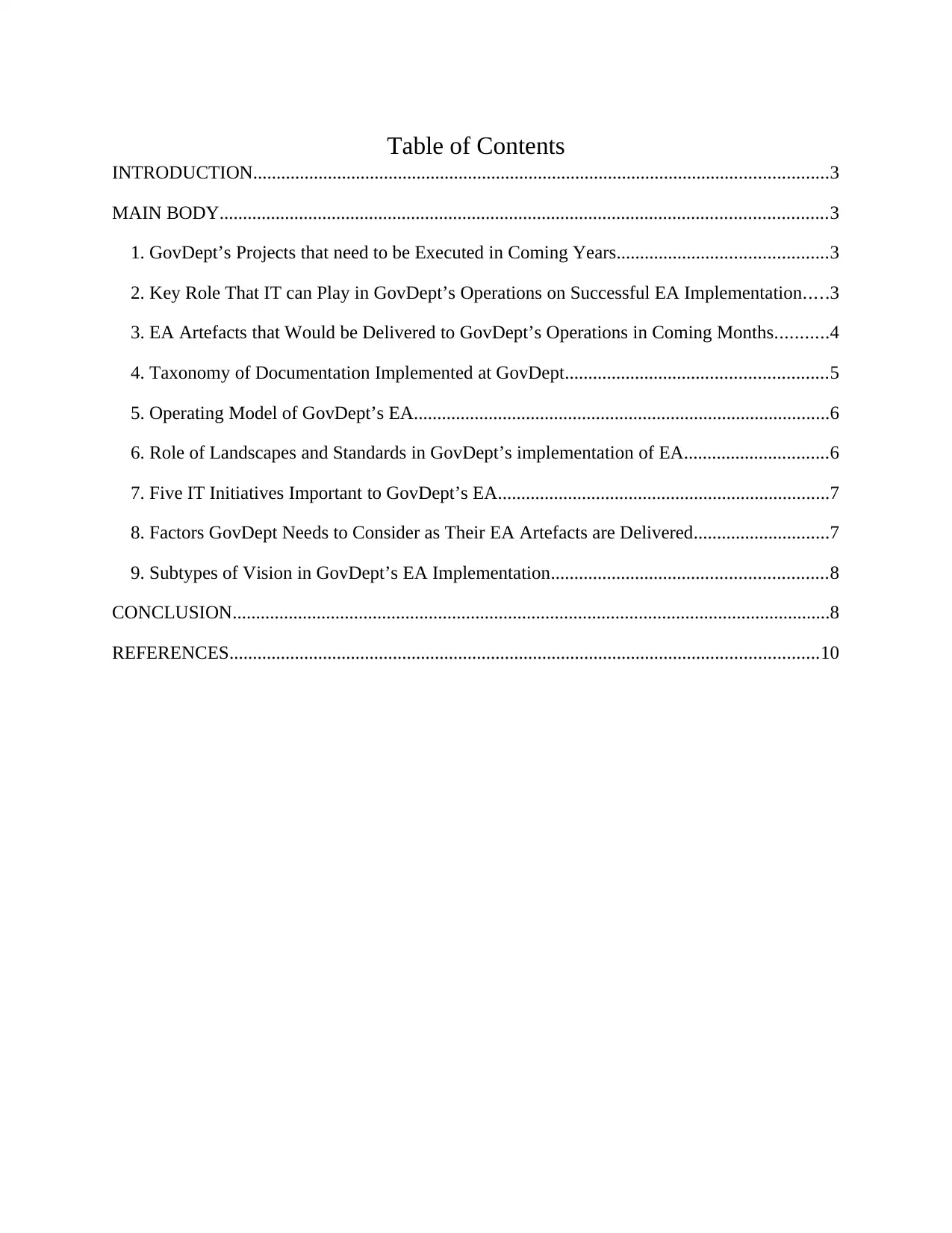
Table of Contents
INTRODUCTION...........................................................................................................................3
MAIN BODY..................................................................................................................................3
1. GovDept’s Projects that need to be Executed in Coming Years.............................................3
2. Key Role That IT can Play in GovDept’s Operations on Successful EA Implementation.....3
3. EA Artefacts that Would be Delivered to GovDept’s Operations in Coming Months...........4
4. Taxonomy of Documentation Implemented at GovDept........................................................5
5. Operating Model of GovDept’s EA.........................................................................................6
6. Role of Landscapes and Standards in GovDept’s implementation of EA...............................6
7. Five IT Initiatives Important to GovDept’s EA.......................................................................7
8. Factors GovDept Needs to Consider as Their EA Artefacts are Delivered.............................7
9. Subtypes of Vision in GovDept’s EA Implementation...........................................................8
CONCLUSION................................................................................................................................8
REFERENCES..............................................................................................................................10
INTRODUCTION...........................................................................................................................3
MAIN BODY..................................................................................................................................3
1. GovDept’s Projects that need to be Executed in Coming Years.............................................3
2. Key Role That IT can Play in GovDept’s Operations on Successful EA Implementation.....3
3. EA Artefacts that Would be Delivered to GovDept’s Operations in Coming Months...........4
4. Taxonomy of Documentation Implemented at GovDept........................................................5
5. Operating Model of GovDept’s EA.........................................................................................6
6. Role of Landscapes and Standards in GovDept’s implementation of EA...............................6
7. Five IT Initiatives Important to GovDept’s EA.......................................................................7
8. Factors GovDept Needs to Consider as Their EA Artefacts are Delivered.............................7
9. Subtypes of Vision in GovDept’s EA Implementation...........................................................8
CONCLUSION................................................................................................................................8
REFERENCES..............................................................................................................................10
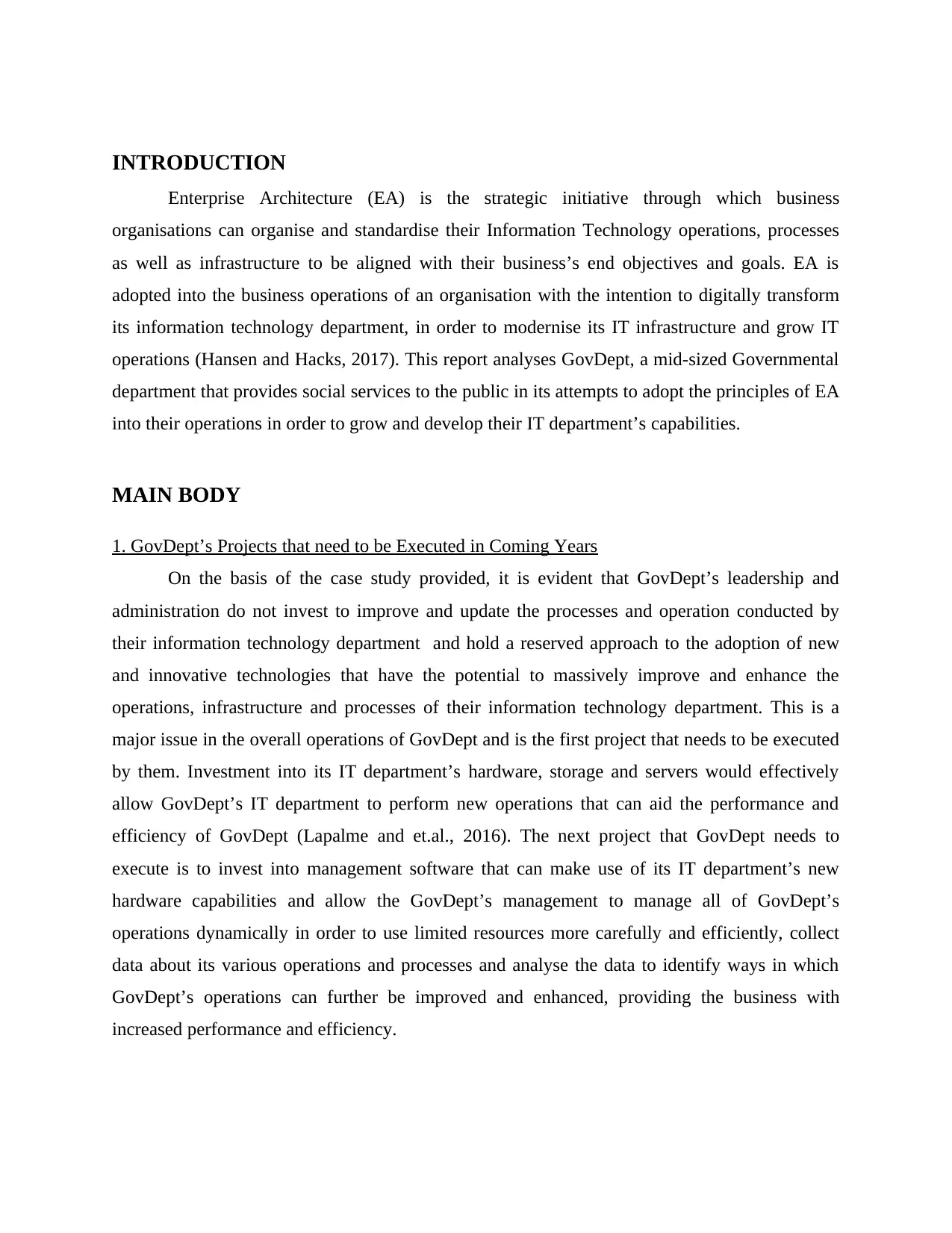
INTRODUCTION
Enterprise Architecture (EA) is the strategic initiative through which business
organisations can organise and standardise their Information Technology operations, processes
as well as infrastructure to be aligned with their business’s end objectives and goals. EA is
adopted into the business operations of an organisation with the intention to digitally transform
its information technology department, in order to modernise its IT infrastructure and grow IT
operations (Hansen and Hacks, 2017). This report analyses GovDept, a mid-sized Governmental
department that provides social services to the public in its attempts to adopt the principles of EA
into their operations in order to grow and develop their IT department’s capabilities.
MAIN BODY
1. GovDept’s Projects that need to be Executed in Coming Years
On the basis of the case study provided, it is evident that GovDept’s leadership and
administration do not invest to improve and update the processes and operation conducted by
their information technology department and hold a reserved approach to the adoption of new
and innovative technologies that have the potential to massively improve and enhance the
operations, infrastructure and processes of their information technology department. This is a
major issue in the overall operations of GovDept and is the first project that needs to be executed
by them. Investment into its IT department’s hardware, storage and servers would effectively
allow GovDept’s IT department to perform new operations that can aid the performance and
efficiency of GovDept (Lapalme and et.al., 2016). The next project that GovDept needs to
execute is to invest into management software that can make use of its IT department’s new
hardware capabilities and allow the GovDept’s management to manage all of GovDept’s
operations dynamically in order to use limited resources more carefully and efficiently, collect
data about its various operations and processes and analyse the data to identify ways in which
GovDept’s operations can further be improved and enhanced, providing the business with
increased performance and efficiency.
Enterprise Architecture (EA) is the strategic initiative through which business
organisations can organise and standardise their Information Technology operations, processes
as well as infrastructure to be aligned with their business’s end objectives and goals. EA is
adopted into the business operations of an organisation with the intention to digitally transform
its information technology department, in order to modernise its IT infrastructure and grow IT
operations (Hansen and Hacks, 2017). This report analyses GovDept, a mid-sized Governmental
department that provides social services to the public in its attempts to adopt the principles of EA
into their operations in order to grow and develop their IT department’s capabilities.
MAIN BODY
1. GovDept’s Projects that need to be Executed in Coming Years
On the basis of the case study provided, it is evident that GovDept’s leadership and
administration do not invest to improve and update the processes and operation conducted by
their information technology department and hold a reserved approach to the adoption of new
and innovative technologies that have the potential to massively improve and enhance the
operations, infrastructure and processes of their information technology department. This is a
major issue in the overall operations of GovDept and is the first project that needs to be executed
by them. Investment into its IT department’s hardware, storage and servers would effectively
allow GovDept’s IT department to perform new operations that can aid the performance and
efficiency of GovDept (Lapalme and et.al., 2016). The next project that GovDept needs to
execute is to invest into management software that can make use of its IT department’s new
hardware capabilities and allow the GovDept’s management to manage all of GovDept’s
operations dynamically in order to use limited resources more carefully and efficiently, collect
data about its various operations and processes and analyse the data to identify ways in which
GovDept’s operations can further be improved and enhanced, providing the business with
increased performance and efficiency.
⊘ This is a preview!⊘
Do you want full access?
Subscribe today to unlock all pages.

Trusted by 1+ million students worldwide
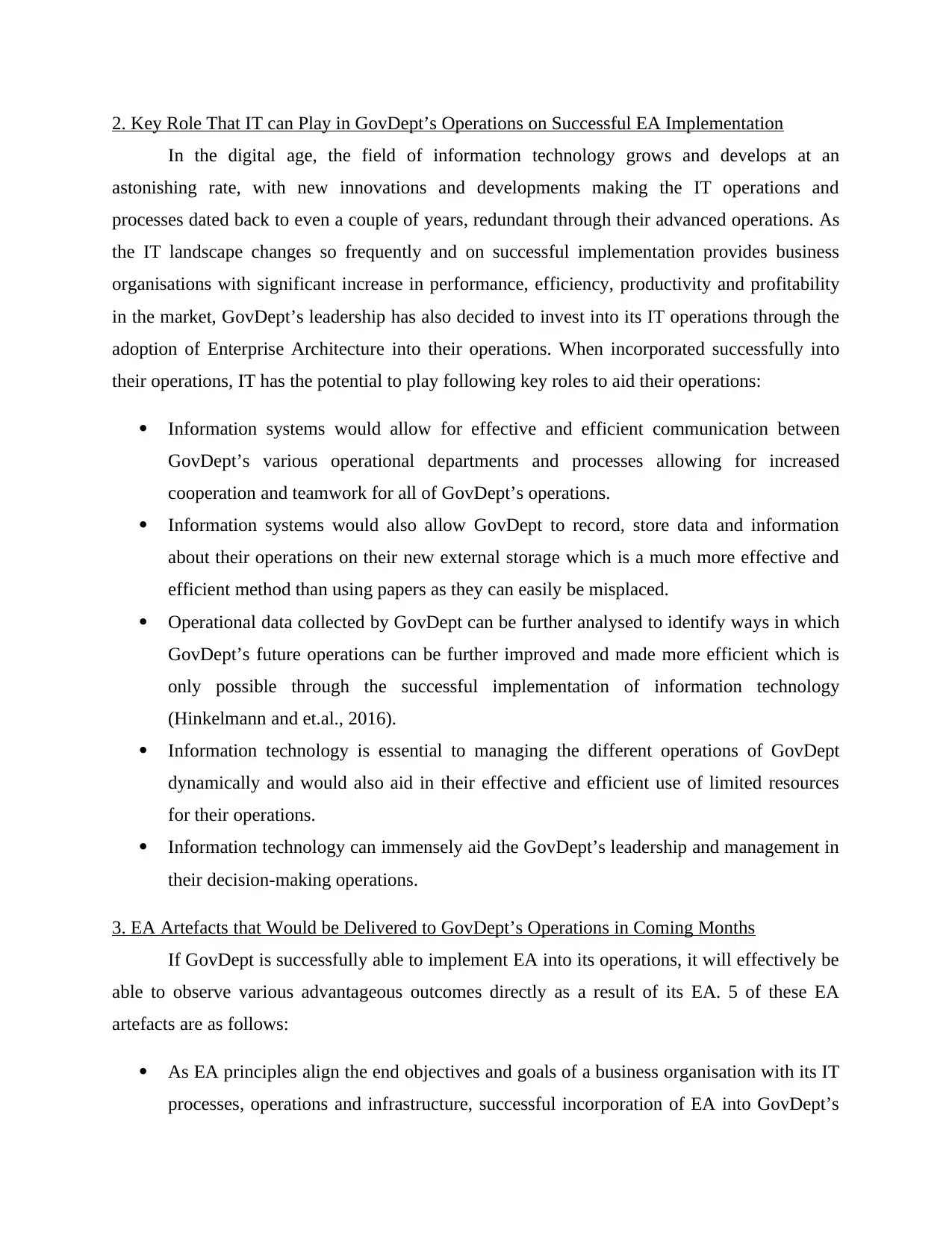
2. Key Role That IT can Play in GovDept’s Operations on Successful EA Implementation
In the digital age, the field of information technology grows and develops at an
astonishing rate, with new innovations and developments making the IT operations and
processes dated back to even a couple of years, redundant through their advanced operations. As
the IT landscape changes so frequently and on successful implementation provides business
organisations with significant increase in performance, efficiency, productivity and profitability
in the market, GovDept’s leadership has also decided to invest into its IT operations through the
adoption of Enterprise Architecture into their operations. When incorporated successfully into
their operations, IT has the potential to play following key roles to aid their operations:
Information systems would allow for effective and efficient communication between
GovDept’s various operational departments and processes allowing for increased
cooperation and teamwork for all of GovDept’s operations.
Information systems would also allow GovDept to record, store data and information
about their operations on their new external storage which is a much more effective and
efficient method than using papers as they can easily be misplaced.
Operational data collected by GovDept can be further analysed to identify ways in which
GovDept’s future operations can be further improved and made more efficient which is
only possible through the successful implementation of information technology
(Hinkelmann and et.al., 2016).
Information technology is essential to managing the different operations of GovDept
dynamically and would also aid in their effective and efficient use of limited resources
for their operations.
Information technology can immensely aid the GovDept’s leadership and management in
their decision-making operations.
3. EA Artefacts that Would be Delivered to GovDept’s Operations in Coming Months
If GovDept is successfully able to implement EA into its operations, it will effectively be
able to observe various advantageous outcomes directly as a result of its EA. 5 of these EA
artefacts are as follows:
As EA principles align the end objectives and goals of a business organisation with its IT
processes, operations and infrastructure, successful incorporation of EA into GovDept’s
In the digital age, the field of information technology grows and develops at an
astonishing rate, with new innovations and developments making the IT operations and
processes dated back to even a couple of years, redundant through their advanced operations. As
the IT landscape changes so frequently and on successful implementation provides business
organisations with significant increase in performance, efficiency, productivity and profitability
in the market, GovDept’s leadership has also decided to invest into its IT operations through the
adoption of Enterprise Architecture into their operations. When incorporated successfully into
their operations, IT has the potential to play following key roles to aid their operations:
Information systems would allow for effective and efficient communication between
GovDept’s various operational departments and processes allowing for increased
cooperation and teamwork for all of GovDept’s operations.
Information systems would also allow GovDept to record, store data and information
about their operations on their new external storage which is a much more effective and
efficient method than using papers as they can easily be misplaced.
Operational data collected by GovDept can be further analysed to identify ways in which
GovDept’s future operations can be further improved and made more efficient which is
only possible through the successful implementation of information technology
(Hinkelmann and et.al., 2016).
Information technology is essential to managing the different operations of GovDept
dynamically and would also aid in their effective and efficient use of limited resources
for their operations.
Information technology can immensely aid the GovDept’s leadership and management in
their decision-making operations.
3. EA Artefacts that Would be Delivered to GovDept’s Operations in Coming Months
If GovDept is successfully able to implement EA into its operations, it will effectively be
able to observe various advantageous outcomes directly as a result of its EA. 5 of these EA
artefacts are as follows:
As EA principles align the end objectives and goals of a business organisation with its IT
processes, operations and infrastructure, successful incorporation of EA into GovDept’s
Paraphrase This Document
Need a fresh take? Get an instant paraphrase of this document with our AI Paraphraser
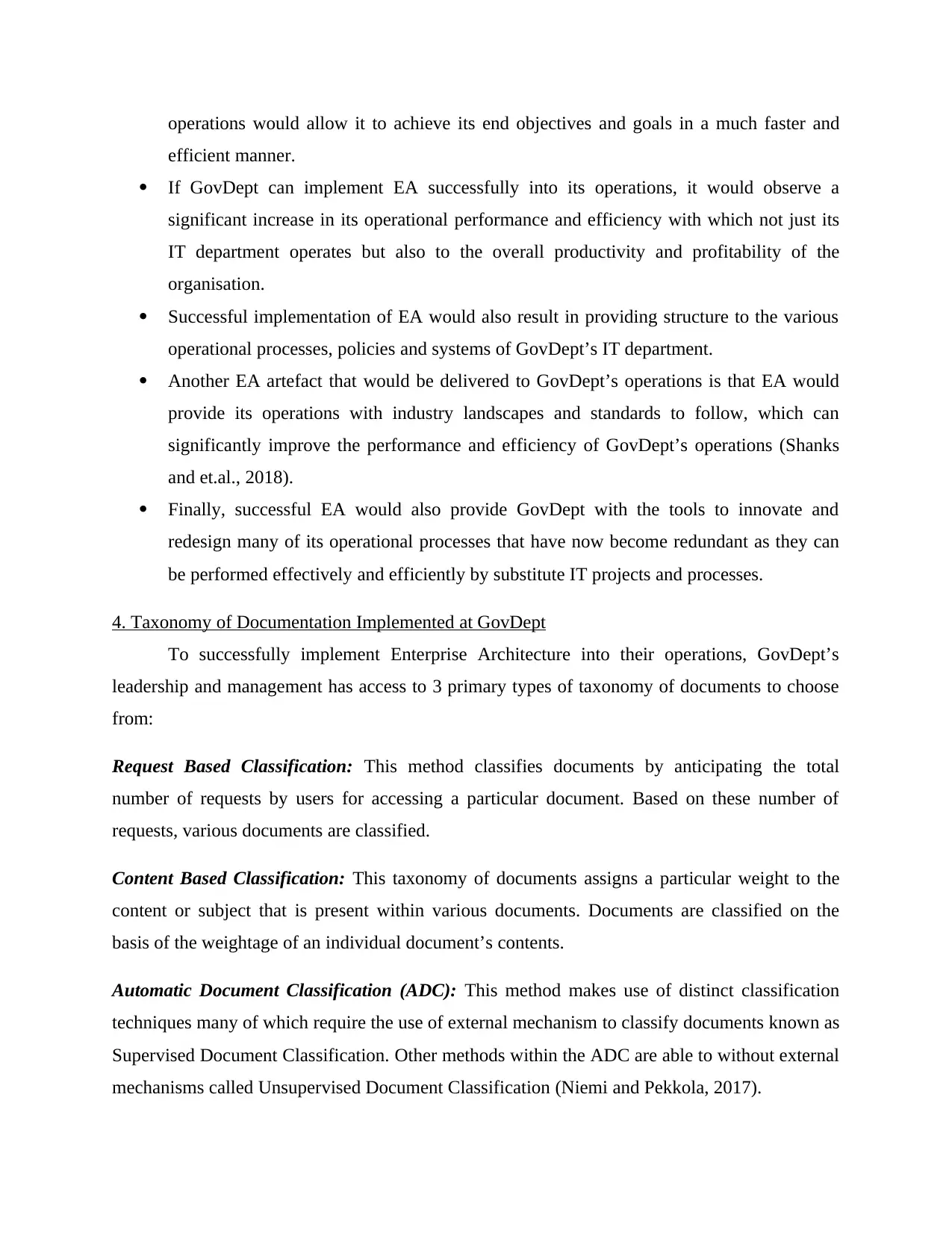
operations would allow it to achieve its end objectives and goals in a much faster and
efficient manner.
If GovDept can implement EA successfully into its operations, it would observe a
significant increase in its operational performance and efficiency with which not just its
IT department operates but also to the overall productivity and profitability of the
organisation.
Successful implementation of EA would also result in providing structure to the various
operational processes, policies and systems of GovDept’s IT department.
Another EA artefact that would be delivered to GovDept’s operations is that EA would
provide its operations with industry landscapes and standards to follow, which can
significantly improve the performance and efficiency of GovDept’s operations (Shanks
and et.al., 2018).
Finally, successful EA would also provide GovDept with the tools to innovate and
redesign many of its operational processes that have now become redundant as they can
be performed effectively and efficiently by substitute IT projects and processes.
4. Taxonomy of Documentation Implemented at GovDept
To successfully implement Enterprise Architecture into their operations, GovDept’s
leadership and management has access to 3 primary types of taxonomy of documents to choose
from:
Request Based Classification: This method classifies documents by anticipating the total
number of requests by users for accessing a particular document. Based on these number of
requests, various documents are classified.
Content Based Classification: This taxonomy of documents assigns a particular weight to the
content or subject that is present within various documents. Documents are classified on the
basis of the weightage of an individual document’s contents.
Automatic Document Classification (ADC): This method makes use of distinct classification
techniques many of which require the use of external mechanism to classify documents known as
Supervised Document Classification. Other methods within the ADC are able to without external
mechanisms called Unsupervised Document Classification (Niemi and Pekkola, 2017).
efficient manner.
If GovDept can implement EA successfully into its operations, it would observe a
significant increase in its operational performance and efficiency with which not just its
IT department operates but also to the overall productivity and profitability of the
organisation.
Successful implementation of EA would also result in providing structure to the various
operational processes, policies and systems of GovDept’s IT department.
Another EA artefact that would be delivered to GovDept’s operations is that EA would
provide its operations with industry landscapes and standards to follow, which can
significantly improve the performance and efficiency of GovDept’s operations (Shanks
and et.al., 2018).
Finally, successful EA would also provide GovDept with the tools to innovate and
redesign many of its operational processes that have now become redundant as they can
be performed effectively and efficiently by substitute IT projects and processes.
4. Taxonomy of Documentation Implemented at GovDept
To successfully implement Enterprise Architecture into their operations, GovDept’s
leadership and management has access to 3 primary types of taxonomy of documents to choose
from:
Request Based Classification: This method classifies documents by anticipating the total
number of requests by users for accessing a particular document. Based on these number of
requests, various documents are classified.
Content Based Classification: This taxonomy of documents assigns a particular weight to the
content or subject that is present within various documents. Documents are classified on the
basis of the weightage of an individual document’s contents.
Automatic Document Classification (ADC): This method makes use of distinct classification
techniques many of which require the use of external mechanism to classify documents known as
Supervised Document Classification. Other methods within the ADC are able to without external
mechanisms called Unsupervised Document Classification (Niemi and Pekkola, 2017).
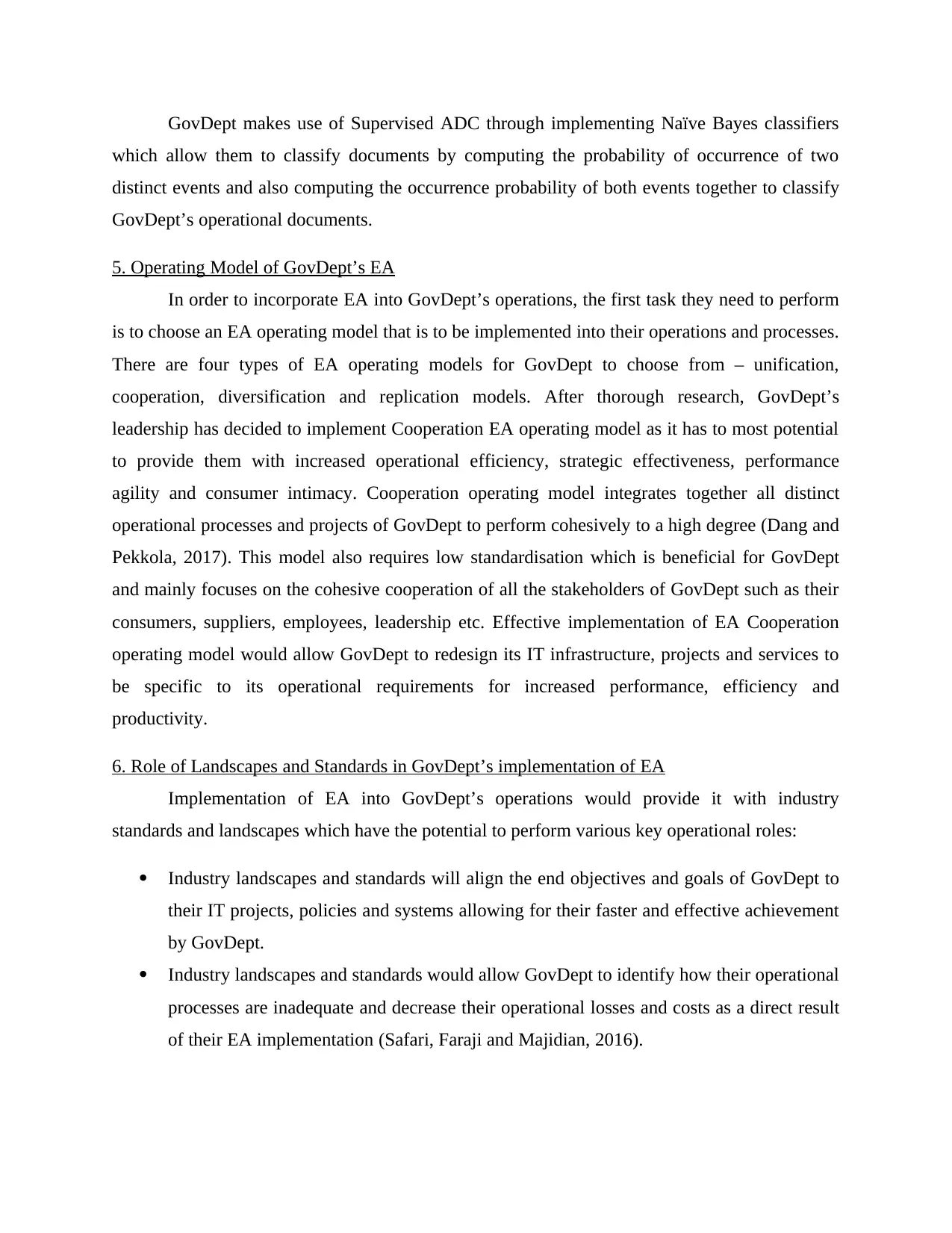
GovDept makes use of Supervised ADC through implementing Naïve Bayes classifiers
which allow them to classify documents by computing the probability of occurrence of two
distinct events and also computing the occurrence probability of both events together to classify
GovDept’s operational documents.
5. Operating Model of GovDept’s EA
In order to incorporate EA into GovDept’s operations, the first task they need to perform
is to choose an EA operating model that is to be implemented into their operations and processes.
There are four types of EA operating models for GovDept to choose from – unification,
cooperation, diversification and replication models. After thorough research, GovDept’s
leadership has decided to implement Cooperation EA operating model as it has to most potential
to provide them with increased operational efficiency, strategic effectiveness, performance
agility and consumer intimacy. Cooperation operating model integrates together all distinct
operational processes and projects of GovDept to perform cohesively to a high degree (Dang and
Pekkola, 2017). This model also requires low standardisation which is beneficial for GovDept
and mainly focuses on the cohesive cooperation of all the stakeholders of GovDept such as their
consumers, suppliers, employees, leadership etc. Effective implementation of EA Cooperation
operating model would allow GovDept to redesign its IT infrastructure, projects and services to
be specific to its operational requirements for increased performance, efficiency and
productivity.
6. Role of Landscapes and Standards in GovDept’s implementation of EA
Implementation of EA into GovDept’s operations would provide it with industry
standards and landscapes which have the potential to perform various key operational roles:
Industry landscapes and standards will align the end objectives and goals of GovDept to
their IT projects, policies and systems allowing for their faster and effective achievement
by GovDept.
Industry landscapes and standards would allow GovDept to identify how their operational
processes are inadequate and decrease their operational losses and costs as a direct result
of their EA implementation (Safari, Faraji and Majidian, 2016).
which allow them to classify documents by computing the probability of occurrence of two
distinct events and also computing the occurrence probability of both events together to classify
GovDept’s operational documents.
5. Operating Model of GovDept’s EA
In order to incorporate EA into GovDept’s operations, the first task they need to perform
is to choose an EA operating model that is to be implemented into their operations and processes.
There are four types of EA operating models for GovDept to choose from – unification,
cooperation, diversification and replication models. After thorough research, GovDept’s
leadership has decided to implement Cooperation EA operating model as it has to most potential
to provide them with increased operational efficiency, strategic effectiveness, performance
agility and consumer intimacy. Cooperation operating model integrates together all distinct
operational processes and projects of GovDept to perform cohesively to a high degree (Dang and
Pekkola, 2017). This model also requires low standardisation which is beneficial for GovDept
and mainly focuses on the cohesive cooperation of all the stakeholders of GovDept such as their
consumers, suppliers, employees, leadership etc. Effective implementation of EA Cooperation
operating model would allow GovDept to redesign its IT infrastructure, projects and services to
be specific to its operational requirements for increased performance, efficiency and
productivity.
6. Role of Landscapes and Standards in GovDept’s implementation of EA
Implementation of EA into GovDept’s operations would provide it with industry
standards and landscapes which have the potential to perform various key operational roles:
Industry landscapes and standards will align the end objectives and goals of GovDept to
their IT projects, policies and systems allowing for their faster and effective achievement
by GovDept.
Industry landscapes and standards would allow GovDept to identify how their operational
processes are inadequate and decrease their operational losses and costs as a direct result
of their EA implementation (Safari, Faraji and Majidian, 2016).
⊘ This is a preview!⊘
Do you want full access?
Subscribe today to unlock all pages.

Trusted by 1+ million students worldwide
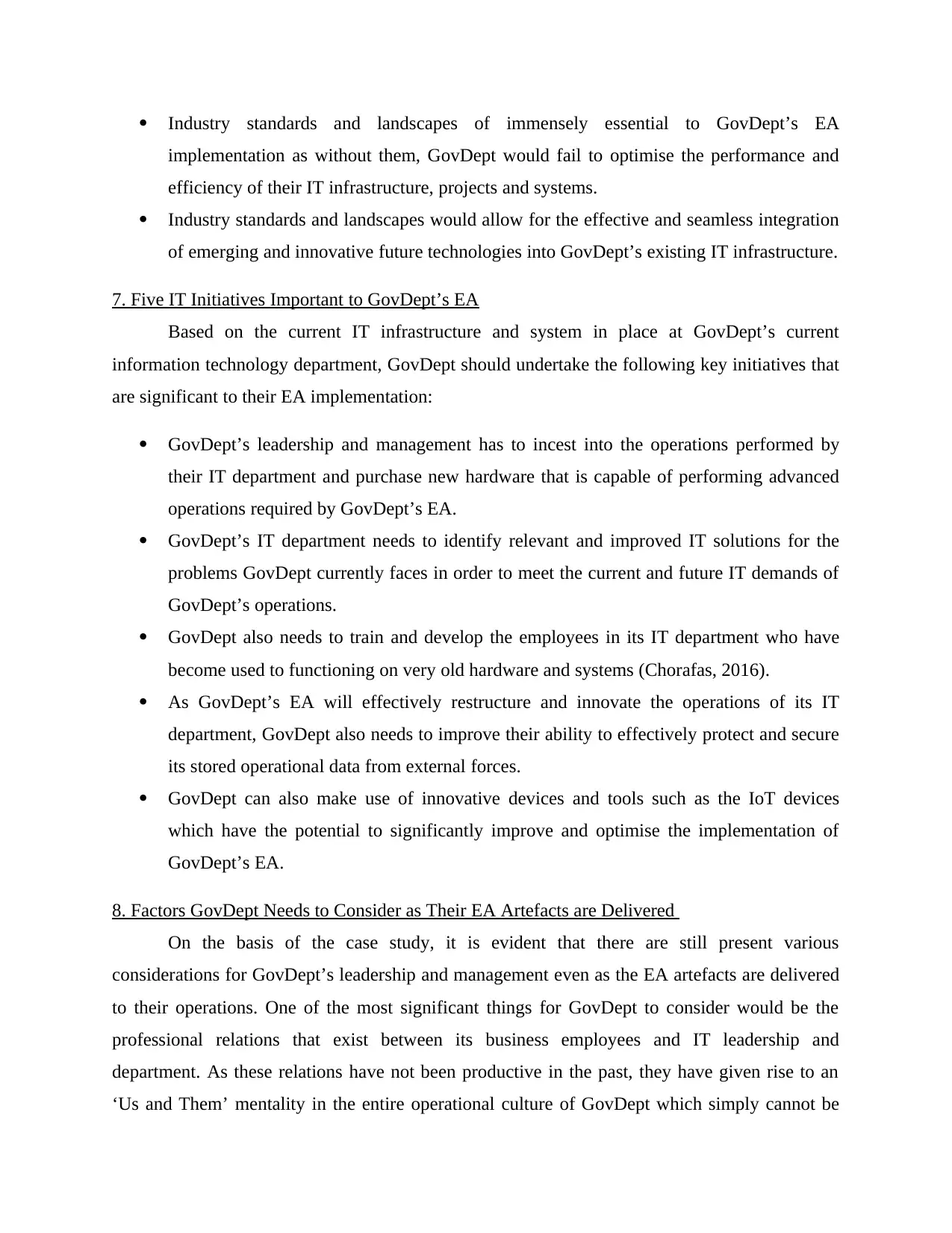
Industry standards and landscapes of immensely essential to GovDept’s EA
implementation as without them, GovDept would fail to optimise the performance and
efficiency of their IT infrastructure, projects and systems.
Industry standards and landscapes would allow for the effective and seamless integration
of emerging and innovative future technologies into GovDept’s existing IT infrastructure.
7. Five IT Initiatives Important to GovDept’s EA
Based on the current IT infrastructure and system in place at GovDept’s current
information technology department, GovDept should undertake the following key initiatives that
are significant to their EA implementation:
GovDept’s leadership and management has to incest into the operations performed by
their IT department and purchase new hardware that is capable of performing advanced
operations required by GovDept’s EA.
GovDept’s IT department needs to identify relevant and improved IT solutions for the
problems GovDept currently faces in order to meet the current and future IT demands of
GovDept’s operations.
GovDept also needs to train and develop the employees in its IT department who have
become used to functioning on very old hardware and systems (Chorafas, 2016).
As GovDept’s EA will effectively restructure and innovate the operations of its IT
department, GovDept also needs to improve their ability to effectively protect and secure
its stored operational data from external forces.
GovDept can also make use of innovative devices and tools such as the IoT devices
which have the potential to significantly improve and optimise the implementation of
GovDept’s EA.
8. Factors GovDept Needs to Consider as Their EA Artefacts are Delivered
On the basis of the case study, it is evident that there are still present various
considerations for GovDept’s leadership and management even as the EA artefacts are delivered
to their operations. One of the most significant things for GovDept to consider would be the
professional relations that exist between its business employees and IT leadership and
department. As these relations have not been productive in the past, they have given rise to an
‘Us and Them’ mentality in the entire operational culture of GovDept which simply cannot be
implementation as without them, GovDept would fail to optimise the performance and
efficiency of their IT infrastructure, projects and systems.
Industry standards and landscapes would allow for the effective and seamless integration
of emerging and innovative future technologies into GovDept’s existing IT infrastructure.
7. Five IT Initiatives Important to GovDept’s EA
Based on the current IT infrastructure and system in place at GovDept’s current
information technology department, GovDept should undertake the following key initiatives that
are significant to their EA implementation:
GovDept’s leadership and management has to incest into the operations performed by
their IT department and purchase new hardware that is capable of performing advanced
operations required by GovDept’s EA.
GovDept’s IT department needs to identify relevant and improved IT solutions for the
problems GovDept currently faces in order to meet the current and future IT demands of
GovDept’s operations.
GovDept also needs to train and develop the employees in its IT department who have
become used to functioning on very old hardware and systems (Chorafas, 2016).
As GovDept’s EA will effectively restructure and innovate the operations of its IT
department, GovDept also needs to improve their ability to effectively protect and secure
its stored operational data from external forces.
GovDept can also make use of innovative devices and tools such as the IoT devices
which have the potential to significantly improve and optimise the implementation of
GovDept’s EA.
8. Factors GovDept Needs to Consider as Their EA Artefacts are Delivered
On the basis of the case study, it is evident that there are still present various
considerations for GovDept’s leadership and management even as the EA artefacts are delivered
to their operations. One of the most significant things for GovDept to consider would be the
professional relations that exist between its business employees and IT leadership and
department. As these relations have not been productive in the past, they have given rise to an
‘Us and Them’ mentality in the entire operational culture of GovDept which simply cannot be
Paraphrase This Document
Need a fresh take? Get an instant paraphrase of this document with our AI Paraphraser
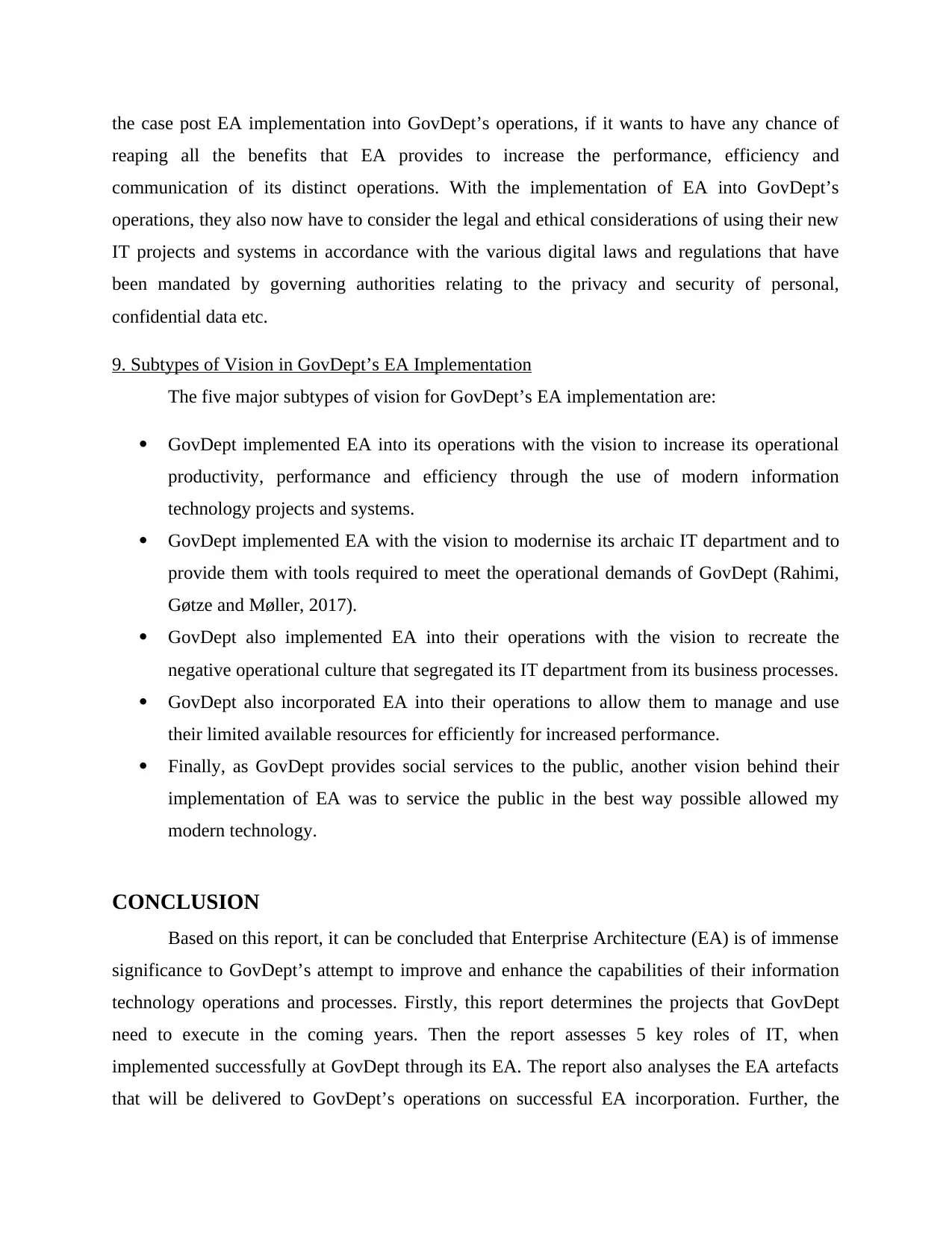
the case post EA implementation into GovDept’s operations, if it wants to have any chance of
reaping all the benefits that EA provides to increase the performance, efficiency and
communication of its distinct operations. With the implementation of EA into GovDept’s
operations, they also now have to consider the legal and ethical considerations of using their new
IT projects and systems in accordance with the various digital laws and regulations that have
been mandated by governing authorities relating to the privacy and security of personal,
confidential data etc.
9. Subtypes of Vision in GovDept’s EA Implementation
The five major subtypes of vision for GovDept’s EA implementation are:
GovDept implemented EA into its operations with the vision to increase its operational
productivity, performance and efficiency through the use of modern information
technology projects and systems.
GovDept implemented EA with the vision to modernise its archaic IT department and to
provide them with tools required to meet the operational demands of GovDept (Rahimi,
Gøtze and Møller, 2017).
GovDept also implemented EA into their operations with the vision to recreate the
negative operational culture that segregated its IT department from its business processes.
GovDept also incorporated EA into their operations to allow them to manage and use
their limited available resources for efficiently for increased performance.
Finally, as GovDept provides social services to the public, another vision behind their
implementation of EA was to service the public in the best way possible allowed my
modern technology.
CONCLUSION
Based on this report, it can be concluded that Enterprise Architecture (EA) is of immense
significance to GovDept’s attempt to improve and enhance the capabilities of their information
technology operations and processes. Firstly, this report determines the projects that GovDept
need to execute in the coming years. Then the report assesses 5 key roles of IT, when
implemented successfully at GovDept through its EA. The report also analyses the EA artefacts
that will be delivered to GovDept’s operations on successful EA incorporation. Further, the
reaping all the benefits that EA provides to increase the performance, efficiency and
communication of its distinct operations. With the implementation of EA into GovDept’s
operations, they also now have to consider the legal and ethical considerations of using their new
IT projects and systems in accordance with the various digital laws and regulations that have
been mandated by governing authorities relating to the privacy and security of personal,
confidential data etc.
9. Subtypes of Vision in GovDept’s EA Implementation
The five major subtypes of vision for GovDept’s EA implementation are:
GovDept implemented EA into its operations with the vision to increase its operational
productivity, performance and efficiency through the use of modern information
technology projects and systems.
GovDept implemented EA with the vision to modernise its archaic IT department and to
provide them with tools required to meet the operational demands of GovDept (Rahimi,
Gøtze and Møller, 2017).
GovDept also implemented EA into their operations with the vision to recreate the
negative operational culture that segregated its IT department from its business processes.
GovDept also incorporated EA into their operations to allow them to manage and use
their limited available resources for efficiently for increased performance.
Finally, as GovDept provides social services to the public, another vision behind their
implementation of EA was to service the public in the best way possible allowed my
modern technology.
CONCLUSION
Based on this report, it can be concluded that Enterprise Architecture (EA) is of immense
significance to GovDept’s attempt to improve and enhance the capabilities of their information
technology operations and processes. Firstly, this report determines the projects that GovDept
need to execute in the coming years. Then the report assesses 5 key roles of IT, when
implemented successfully at GovDept through its EA. The report also analyses the EA artefacts
that will be delivered to GovDept’s operations on successful EA incorporation. Further, the
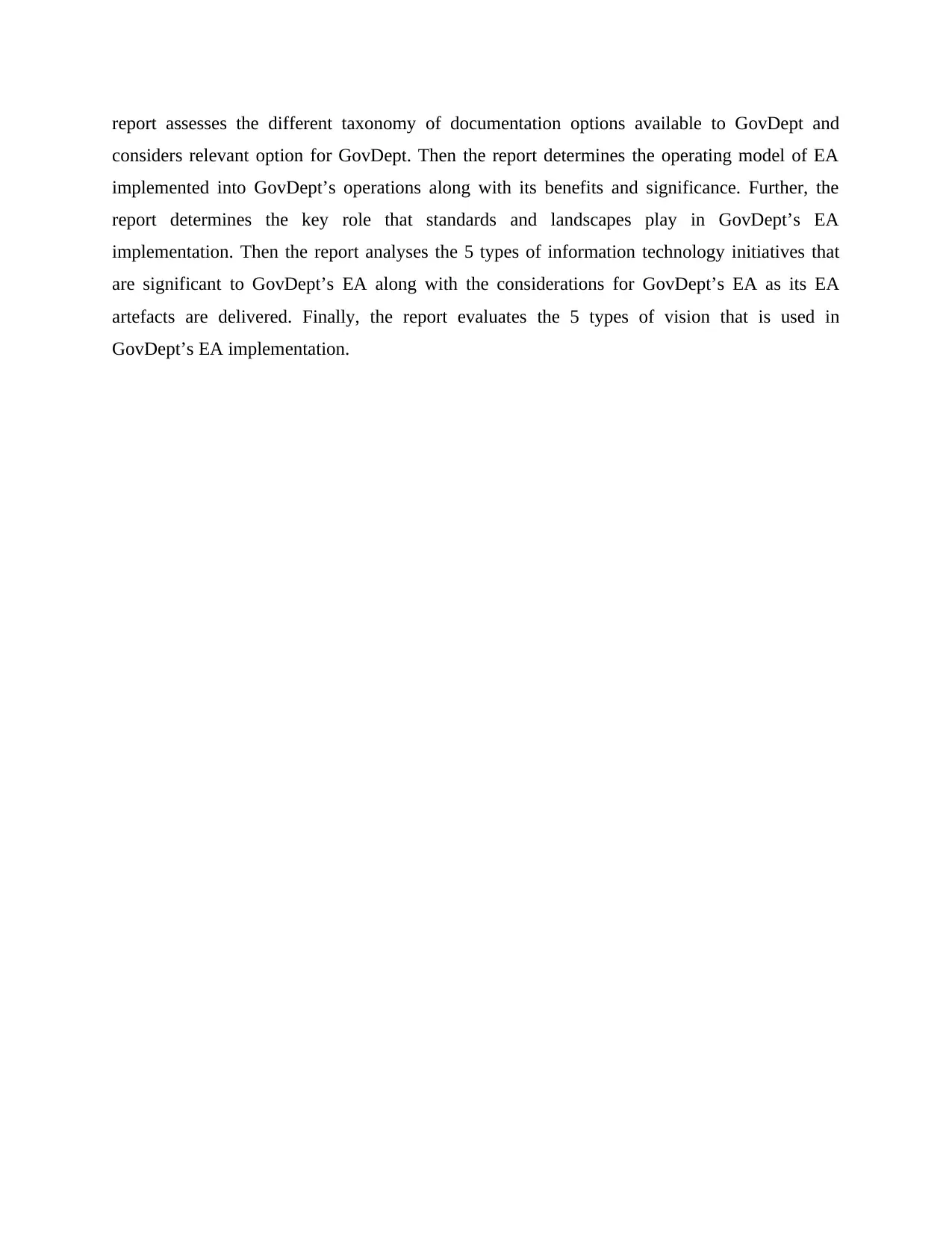
report assesses the different taxonomy of documentation options available to GovDept and
considers relevant option for GovDept. Then the report determines the operating model of EA
implemented into GovDept’s operations along with its benefits and significance. Further, the
report determines the key role that standards and landscapes play in GovDept’s EA
implementation. Then the report analyses the 5 types of information technology initiatives that
are significant to GovDept’s EA along with the considerations for GovDept’s EA as its EA
artefacts are delivered. Finally, the report evaluates the 5 types of vision that is used in
GovDept’s EA implementation.
considers relevant option for GovDept. Then the report determines the operating model of EA
implemented into GovDept’s operations along with its benefits and significance. Further, the
report determines the key role that standards and landscapes play in GovDept’s EA
implementation. Then the report analyses the 5 types of information technology initiatives that
are significant to GovDept’s EA along with the considerations for GovDept’s EA as its EA
artefacts are delivered. Finally, the report evaluates the 5 types of vision that is used in
GovDept’s EA implementation.
⊘ This is a preview!⊘
Do you want full access?
Subscribe today to unlock all pages.

Trusted by 1+ million students worldwide
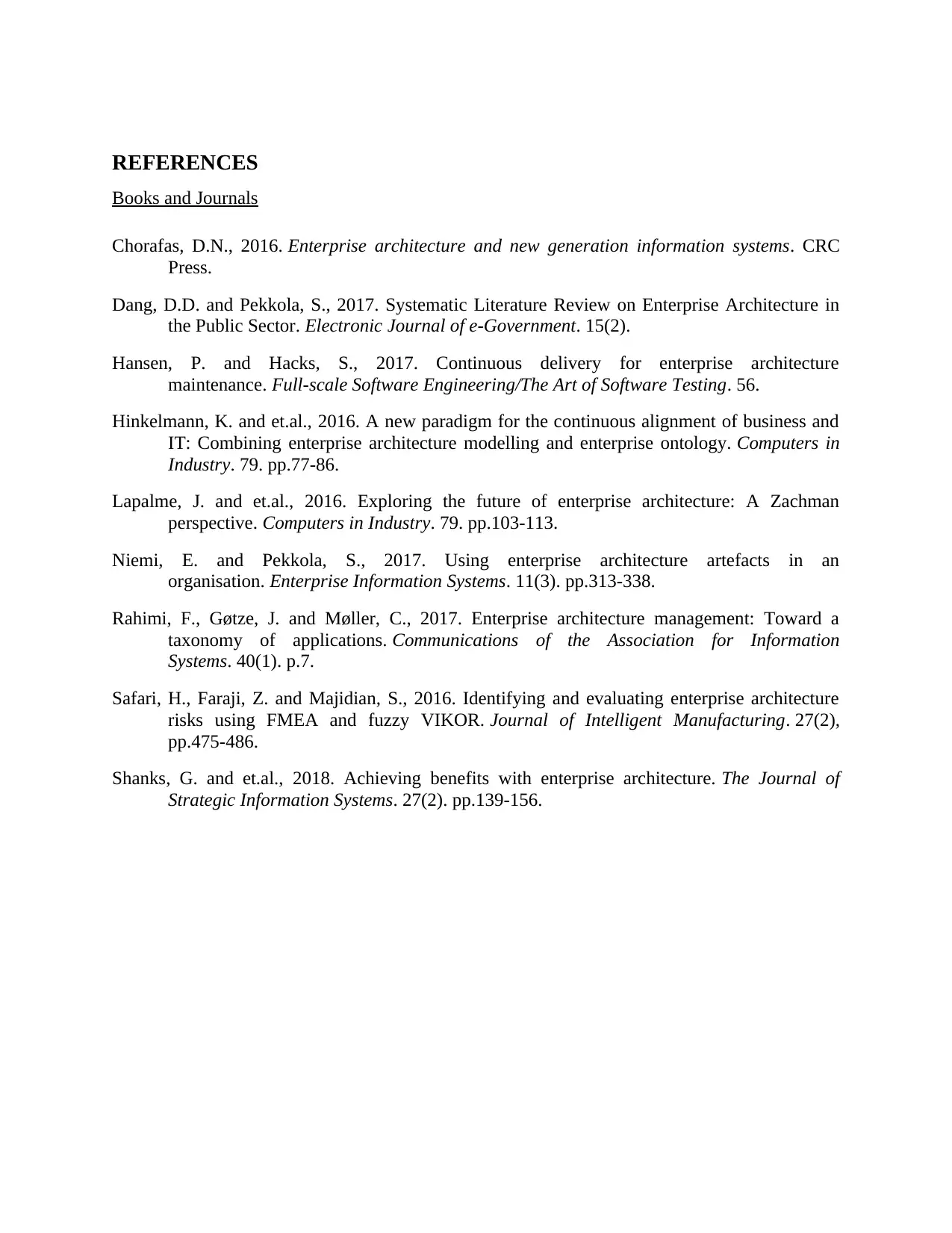
REFERENCES
Books and Journals
Chorafas, D.N., 2016. Enterprise architecture and new generation information systems. CRC
Press.
Dang, D.D. and Pekkola, S., 2017. Systematic Literature Review on Enterprise Architecture in
the Public Sector. Electronic Journal of e-Government. 15(2).
Hansen, P. and Hacks, S., 2017. Continuous delivery for enterprise architecture
maintenance. Full-scale Software Engineering/The Art of Software Testing. 56.
Hinkelmann, K. and et.al., 2016. A new paradigm for the continuous alignment of business and
IT: Combining enterprise architecture modelling and enterprise ontology. Computers in
Industry. 79. pp.77-86.
Lapalme, J. and et.al., 2016. Exploring the future of enterprise architecture: A Zachman
perspective. Computers in Industry. 79. pp.103-113.
Niemi, E. and Pekkola, S., 2017. Using enterprise architecture artefacts in an
organisation. Enterprise Information Systems. 11(3). pp.313-338.
Rahimi, F., Gøtze, J. and Møller, C., 2017. Enterprise architecture management: Toward a
taxonomy of applications. Communications of the Association for Information
Systems. 40(1). p.7.
Safari, H., Faraji, Z. and Majidian, S., 2016. Identifying and evaluating enterprise architecture
risks using FMEA and fuzzy VIKOR. Journal of Intelligent Manufacturing. 27(2),
pp.475-486.
Shanks, G. and et.al., 2018. Achieving benefits with enterprise architecture. The Journal of
Strategic Information Systems. 27(2). pp.139-156.
Books and Journals
Chorafas, D.N., 2016. Enterprise architecture and new generation information systems. CRC
Press.
Dang, D.D. and Pekkola, S., 2017. Systematic Literature Review on Enterprise Architecture in
the Public Sector. Electronic Journal of e-Government. 15(2).
Hansen, P. and Hacks, S., 2017. Continuous delivery for enterprise architecture
maintenance. Full-scale Software Engineering/The Art of Software Testing. 56.
Hinkelmann, K. and et.al., 2016. A new paradigm for the continuous alignment of business and
IT: Combining enterprise architecture modelling and enterprise ontology. Computers in
Industry. 79. pp.77-86.
Lapalme, J. and et.al., 2016. Exploring the future of enterprise architecture: A Zachman
perspective. Computers in Industry. 79. pp.103-113.
Niemi, E. and Pekkola, S., 2017. Using enterprise architecture artefacts in an
organisation. Enterprise Information Systems. 11(3). pp.313-338.
Rahimi, F., Gøtze, J. and Møller, C., 2017. Enterprise architecture management: Toward a
taxonomy of applications. Communications of the Association for Information
Systems. 40(1). p.7.
Safari, H., Faraji, Z. and Majidian, S., 2016. Identifying and evaluating enterprise architecture
risks using FMEA and fuzzy VIKOR. Journal of Intelligent Manufacturing. 27(2),
pp.475-486.
Shanks, G. and et.al., 2018. Achieving benefits with enterprise architecture. The Journal of
Strategic Information Systems. 27(2). pp.139-156.
1 out of 10
Related Documents
Your All-in-One AI-Powered Toolkit for Academic Success.
+13062052269
info@desklib.com
Available 24*7 on WhatsApp / Email
![[object Object]](/_next/static/media/star-bottom.7253800d.svg)
Unlock your academic potential
Copyright © 2020–2025 A2Z Services. All Rights Reserved. Developed and managed by ZUCOL.





